|
Part Three: Time to Rest,
Explore, Find New Things and Wonder
or The Mountain Comes Down
Stage
I you he she we.
In the garden of mystic
lovers,
I you he she we.
I you he she we.
In the garden of mystic
lovers,
These are not true
distinctions-
I you he she we.
This is a saying (since
most of his poetry was verbal) by Rumi, a 13th
century Islamic mystic poet, who believed that all people
were one and could live together, understand our similar
hearts and exist in peaceful, close harmony.
Where have we been? We started in an ordered world,
an ABA placement of things (a human world). We started with
two travelers who became three somewhere in the voyage. We
saw in nature, green, the steadfastness of friendship and
the coming back of old friends (just as the American Indians
believe that no time exists between departure and return for
those we love). We, hopefully for this journey, took off our
watches and suspended time. We promised ourselves that we
would keep our eyes open and experience all that we could.
We moved on and found places to rest and reflect (looking
back on where we have been). The scenery has changed. We
notice and welcome the change. We allow the water and our
guide to slowly take us along the lake.
Orientation: When we rested in our second viewing of
the scroll, we found that our guide was sometimes blinded by
his love of what he saw and that he realized that so his
reasoned observations could have the ring of truth to them.
His wife, who always goes on these trips with him, commented
with tongue partially in her cheek, “It is interesting that
we both have the same tastes. We both love the same
thing. I love you and you love you.” When we were first
dating over 50 years ago, I remember telling her that I
thought, “You cannot love others and the world without first
loving yourself.” I did not mean for her to bring this
statement up so often but I still consider it true. Everyone
starts with “self” and moves outward. When we get into
troubles where we cannot see an answer, we circle the wagons
to self and those we love “most close." A journey on a lake
where there are no business stresses and pressures, where
the only duty of the traveler is to see and experience, it
is easy to slip into our skins and hug ourselves in the
wonder of the nature that enfolds us. “I just love….” slips
from our lips all the time, meaning “self” and “other."
Frank Lloyd Wright once called architecture, “A womb with a
view.” Our first architecture is “mother”, then cave, then
small house, then condominium, then womb (grave) again. Hmm,
it has a wonderful ABA-form ring to it. It reminds me of
Chinese ideas about the path of the brush in making a stroke
on a page: birth, duration and end. Anyone who exercises in
the early morning light with Tai Chi knows that the breath
of life (directing the ch’i, life spirit, with your tongue
at the roof of your mouth and breathing through your nose,
allowing the ch’i to flow like water over your body) is an
ABA, start in a centering, breathe, move, breathe, move,
return to the center.
The question arises: “What happens in the middle, where we
are now in this journey?” Just when we get comfortable with
the formal order in the world, we must adjust to Murphy’s
Law (things go wrong, whatever “wrong” means). I find that
as a guide on a journey I must learn to adjust to those that
are my fellow travelers. A guide is a kind of manager for
the trip. If the passenger, the fellow traveler, does not
know something, we tell them; if they know a little, we show
them; if they know as much as we do, we work with them; and
if they know more than we do, we listen and learn more so
that we can be better guides. There is always someone who
knows more about some aspect of what nature presents than
you do. A trip together is a sharing of each person’s inner
and outward peace, their comfort with their knowledge.
Remember: In our baggage, we have not taken our worries,
cares, business or the weight of the world with us. That was
left on the shore. Our only purpose is to relax, observe and
learn (with a little wonder thrown in to push us out of our
complacency). We will see things that we saw before (old
friends revisited). We will see patterns that are repeated.
And I hope that we all will notice that the mountain that
sat majestically on the horizon in early scenes has moved
downstage as a principle actor in this lake play.
This is one of several interludes. We are sad to leave
the island, the bulrushes sympathize with our feelings, but
we take off in our sail boats.
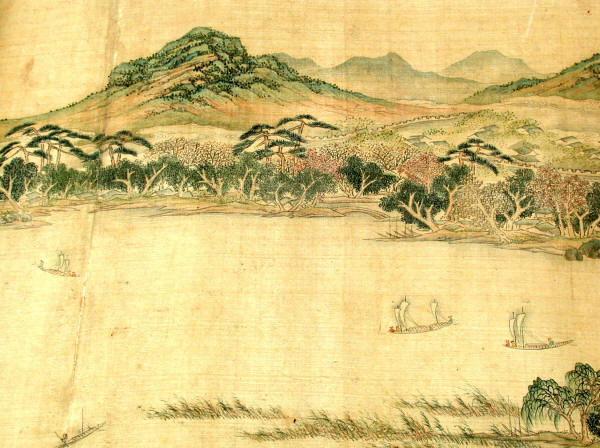
Just as Mark Twain on the Mississippi River knew and
practiced, we take soundings (visual depth readings) to keep
us afloat and moving on.
It is time to thin slice
our vision again:

Many elements of our trip are repeated: green and colored
trees, open water, mountains and mists, boats and travelers
(history).
Evergreens are still tall and straight, yet some trees
lean left; some right; some grow straight (diversity).
The mountain has moved downstage to the foreground
(evolution).
In the background, the rolling line that were hills has
been cut apart by pyramids of dark mountains (surprise).
Rule Four: To find peace,
as much as you take, give back.
For years, as a guide I found that joining a Rotary Club put
me touch with other guides. The "Rotary" motto that started with
Service Not Self has been changed to recognize that none of us really
lose self when we guide in service. We modify that early
historical idea to Service Above Self. It is a hierarchy,
not a denial. One of the tenets of Rotary is a pursuit and
recognition of peaceful journeys. I wonder if Rotary has a
classification called “guide”?
Rule Five: For every trip,
as part of the load in the luggage, we take with us “our
self."
Time to look around:

The first thing we notice, near the horizon, is three
clusters of evergreens. Below that is two boats close
together, with two passengers and two masts beside a boat
with three passengers with three masts. A little way ahead,
to our left, is another two passengers and two masts boat.
For variety and a contrast is a single boat with one mast
and one passenger which points toward the leaning bulrushes.
It and the single boat (with 2 + 2) above are slanted in as
two sides to an open-ended arrow which points back,
reminding us of what we have left behind and the sadness of
our leaving. The boats act as sign posts in the lake,
telling us where to look and what is important.
To our left is a small mountain, covered in Evergreens. Our
eyes and mind can rest here for a time and we can visit with
the other passengers. Who would I want to take with me on
this trip? Who would you?
I will tell you about two of my companions, one who passed
away and one in his youthful 80s, and show you others. The
first was one of the original Texas gamblers, named Sam, and
the second has been called “a successful
Capitalist with a Conscience”, named B. Both I know well and take them on
every trip that I make with my imagination.
On this kind of virtual journey across an image lake, when
we stop many times to reflect, we tell stories of those that
we take with us in our hearts. Continuity is important on a
journey of peace.
Story of Sam: Sam is a Texas gambler. He shares the
grandfather duties of my daughter’s two grandchildren.
Mostly, he is a special human being who is a dying breed in
America, a fiercely independent, competitive-to-a-fault,
story-telling, self-made and sustaining entrepreneur and
marvelous hustler. I have come to know him as a man’s man
(although he is loved by women also). He was born in Mexia,
Texas in 1919, left his home, walked across a field to the
train tracks with thirty-five cents in his pocket, hopped
into an open freight car, headed West and never looked back.
He is a proud man who has made and lost millions, selling
land to city dwellers and playing poker all over the country
(including his new hometown, Waco). His doctor told him that
he is filled with cancer that is spreading. In truth, he is
playing his last hand.
He came to Waco over 60 years ago, to buy 300 to 400 acre
plots, selling them in 5 to 10 acre sites to city people who
wanted the quiet, rural life (at least on weekends), and to
open a bar called the Playboy Lounge, frequented by lawyers,
doctors, college students and faculty, business leaders and
ordinary citizens looking for a “good time." It was there
that he met his future wife, Jewel. During the day Sam would
play poker and dominoes in the Businessmen's’ Club at 5th
and Austin Avenue (when he was not out to find new land to
sell) and ran the bar at night. In those days, there were
three pool/domino halls in downtown Waco. A gambler could
make a living traveling those three spots (as long as he had
an outside source of “sure funds” to play with). Sam had
many outside sources. He had learned his craft with the best
in Texas.
I once asked him, “Sam, who are some of the guys that you
played with?”
He told me: “The list is too long and time is too short but
here are the major ones: Amarillo Slim, Johnny Moss, Blondie
Forbes, Jack Strauss, Sailor (whose real name was Brian
Roberts), Tom Moore, Slim Lambert and Doyle Bronson. Doyle
was the best at no limit poker and Sailor was the best at
limited; that is, right behind me of course. We played all
over Texas, like at Redmond’s in Houston. They had the
biggest games. You had to be good just to sit in. We played
only two games: Texas Hold-‘Em (two cards down and five up)
and Omaha (which is high-low, three cards down and six up).
I was best at Texas Hold-‘Em back then, but now, at the
tables in Waco, I like Omaha. It gives me more flexibility.”
Sam then went on to tell me about the best hustler of all
the ones that he had met in his travels. Titanic Thompson
was his name. He would bet you on anything. One time he bet
a crowd of people that they could not throw a walnut over
the courthouse. The wind was blowing against them. They all
failed. Titanic would go double or nothing, reach into a bag
of walnuts and grab one filled with lead and toss it over
the courthouse. He was famous for moving road signs and then
betting people that he knew that “it would take more miles
to get to Cisco (or whatever town Titanic was approaching)
than the Texas Highway Department marked on their signs.” He
won all the time. You would call him
”a con man” today. Well, he was that and a “hustler." Con
men tell you more than they can do; hustlers always less. I
guess that I am a hustler mostly but I was always honest in
card games, when I bought and sold land, selling insurance
and bootlegging in the 30’s.”
And what kind of poker player was Sam? In his words, “I
played my cards “close to the vest." If I did not have the
cards, normally, I did not play the hand. Of course, with
that kind of reputation, you needed to break the pattern and
buy a hand. You know, he holds a high pair and I raise him
$200 (back when $200 was a huge bet) and took the pot (when
he threw in this cards, knowing that if I bet and raised
that much I had him beat). I was a four-P player: patience,
percentage, position and people. You never play cards in
poker. If you are good, you know and play people. And I was
good!”
Sam loved to tell the story about playing with Doyle Bronson
when the master said: “In poker you have to climb out on the
limb because that is where the fruit is” and “Poker is a
game of too little information.”
One day, when I left him in his hospital room in Dallas, I
thought to myself: “Sam, this is your last hand. Luckily,
you have PEOPLE who care and love you so that is in your
favor, your PATIENCE at the table is legendary but time in
this final hand is running out, your POSITION at the table
is not good (and you cannot fold) and the PERCENTAGES are
all against you.” When remembering our last conversation, I
had to laugh. Sam told me on leaving, “I just finished
reading an article about Martha Stewart who is working on a
new cure for cancer. When she gets out of prison, she will
find that cure. I will be able to put this cancer in
remission and live to see my grandchildren graduate from
high school. You can never tell until the last card is
played.” At that moment in time, I thought, “No, Sam, I
would not bet against you, but I never thought of Martha
Stewart as “lady luck” but, if anyone can find the winning
card with Martha Stewart dealing, you might make me a
believer.”
Sam is gone from the card table. Martha Stewart did not deal
him a final, winning card (the “river” card). “Up the river”
is jail; “down the river” leads to victory and the future.
But when I go on trips where the water is open, the sky
clear, my fellow companions enjoyable, my mind and spirit
totally alive, I notice Sam as one of the passengers,
dealing little bits of Texas-grown wisdom when he asks me,
“Play or fold?” (with just a twinkle of mirth in his voice).
Story of B: One Sunday morning, just as I finished
breakfast and was thinking of laying down again to rest, the
telephone rang. The voice at the other end said, “This is B.
Read your article in the newspaper. Quite good! We will have
to have lunch together and talk. Call my office.” He was
gone again. I knew who B was, everyone in Waco, Texas knew
about the man who made millions by selling insurance to the
trade unions. When I first came to that city, I went to a
speech in the park by B (everyone who is a friend knows him
by “B”). I remember one line, “Taxes are the price of
American democracy.” A book has been written about B and his
friendships with American and foreign presidents, scholars,
politicians and other business leaders, called “Capitalist
with a Conscience." His foundation gives to education,
University of Texas, national causes, international
understanding, the arts and culture. We had our first
luncheon in 1980. We talked of our fathers and how we were
both born into poverty with dignity. We talked ideas. Every
month since then, we have met for lunch and discussed what
was happening in the world, education, the arts and our
travels. He is ten years older than I am and I consider him
a mentor. One day at lunch he said, “Come by this Saturday
and see me in action.” I did and learned much about how to
deal with my employees. He called each one, talked a little
about their plans in life, some of their hopes, the health
and welfare of their family, and then B talked about quotas
and expectations for his national insurance company and how
this person on the other end of the phone could help to make
that vision a reality. From then on, at the art museum where
I was the director, I started each day asking my employees a
little about their family, said a heartfelt “Good Morning”,
and then started the business for that day. I learned that
from B. I do the same as an educator and a guide.
At one luncheon, B told me about his prowess in marbles when
he was growing up in San Antonio. He would beat everyone,
taking all their marbles, and then before departing he would
give them enough back to play the next day. He told me,
“That is one of my rules about giving back the money that I
assemble. You have no one to play with tomorrow if you take
all the marbles and give none back.” When we cannot meet
face to face, we email each other. I write volumes and he
writes enough to get across his point. When he or I write an
article, that is included and commented upon in another
email message. In our luncheon, I have only one rule, “Never
talk money.” I know that I will get a fair hearing at his
Foundation so I apply like everyone else. We talk ideas.
Here are some possible companions from a small Japanese
song book that I found in a marketplace in Kyoto and I
treasure:
With this traveling group of artist/singers/characters,
of course I wish to take my wife Anne on this journey. As an
artist, I can see her as I drew her in the 1950s. That is
the nice thing about taking your imagination with you, time
can flow like water and one’s remembrances can rewind to the
past just as easily as they can unwind to the future. Here
is a pencil drawing:
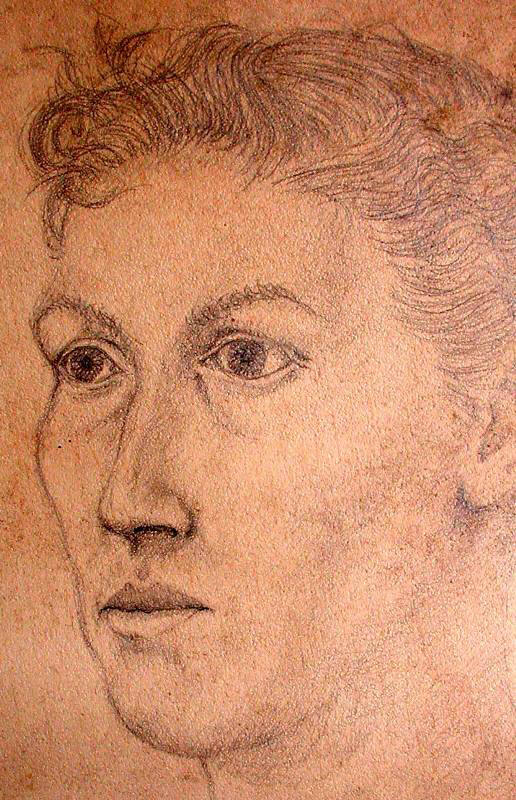

We are on the lake again. In the distance, slightly behind
us, are two mountains that lean back toward where we have
been. They are directional guides to history (the place
where something happened, something was and someone lived).
History is where we are able to travel in the past. As the
bulrushes lean toward the future, our single boat with just
ourselves aboard is tilted upward to stop our eye from going
too far forward. It is almost telling us, “Live in the
moment. It will not come again (except when we rewind the
trip and even then it will be different since we have gone
to other places before returning). One time I went back to
my high school in Pittsburgh which was a vast network of
high ceiling halls and spacious rooms when I attended and
now, on returning years later, is small and claustrophobic.
We have a place to dock. There are others there since we saw
their masts from a distance. It is interesting that we now
see the Evergreens, which we thought of a symbols for a kind
of friendship always steadfast and constant, as arrows that
point our attention in the space of the lake, the void of
the unknown.
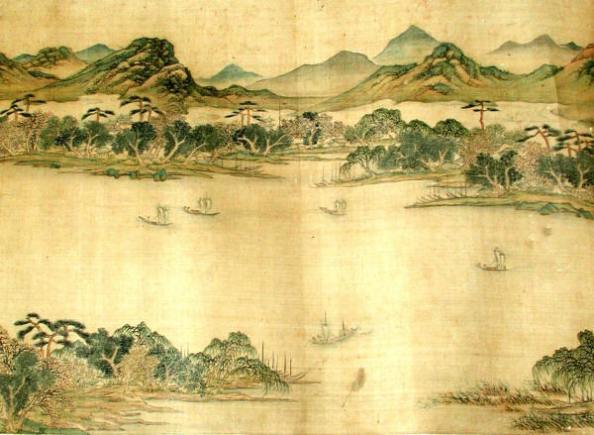
We travel on and look back, recording for some future
thought that the triangle of the small mountain in the
foreground is an arrow into an inlet with no opening
(another triangle leading to a void). The upper broad
triangle is lined with trees of green and splashes of color.
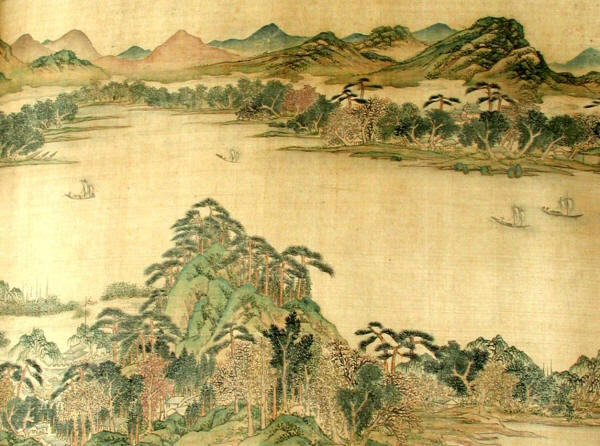
Nowhere do we rush. No place do we feel that time is part of
the scenery. This is an interlude in our lives, a time to
reflect and think back on what has gone before. This is a
time when Peace is a fellow traveler. He/she is dressed in
detailed garments, some color but not overbearing, and some
suggestion of mystery, lace that resembles a mist and
catches that are carved as walled fortresses.
In the sea of green in the foreground are circles of colored
trees. To the left of the mountain is our shelter, with a
wall around it for protection, engulfed in a mist that has
moved from the background in the previous viewing to here
where we now reside.
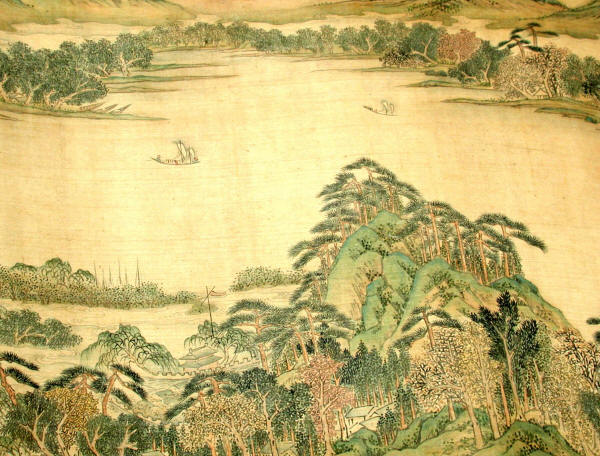
Have you noticed, to the right of our viewing, some of
the trunks of the Evergreens lean toward the future and some
lean back, reminding us of the history of the past?
They seem to support each other. I point out as your
guide, “The trees that lean toward the future are like
children who always impatiently ask, "Are we there yet?"
Some in our party are asking that question now and some are
content to move slowly on while enjoying the view and the
company. Both are correct.
As your guide, I remind
you that we have set up rules for you to follow (or not) but
certainly review. The rules themselves are guides. Peace
cannot be found without some rules to follow and some to
ignore or evolve.
Before we leave this scene, I would be remiss if I did not
tell you, in my judgment, “This small mountain before you is
important. It is the first time that we have seen a small
Northern Sung mountain in the foreground of a Southern Sung
voyage across the lake country in a Southern section of
China.”
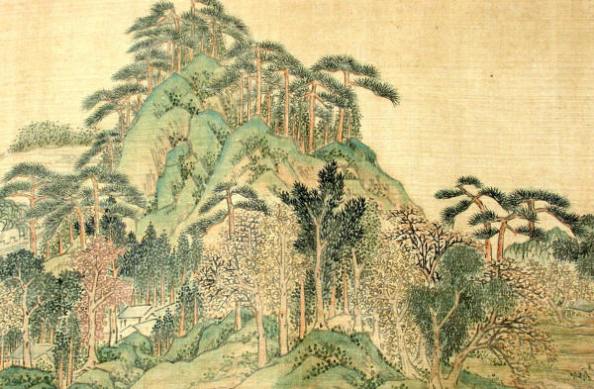
Your head is now full of so much to see that it is time
again to thin slice this one element, a Northern Sung small
mountain:
Covered with tien fa, dots, with patterns that are too
complex to read.
Clustered with trees, old friends from previous scenes.
Populated by dragon spines in the overlaying curves of
the rocks.
Occupied by a shelter with fortress walls and surrounded by
mists (the void or unknown).
To our left, reminded by more weeping willows, sadness
and loss, departure and adventure.
Above the mountain, our one boat continued with two
friends and two masts.
Story: When I attended Dartmouth College in the early
1950s, Robert Frost was the poet in residence and one day,
having trouble with an assignment for a poem of his, I went
to him. I asked: “Can you tell me what this poem means? I
cannot see it.” He answered, “I don’t know. What I do in
creating poems is put in all that I feel, know and can
imagine while leaving holes for your imagination to fill.”
I guess, as your guide, I too try to leave holes for you
to fill so that the imagination is a companion to us all.
The void, the holes, are the unknown that our experiences,
our histories and our insights can fill.
Send us things to fill these
holes. Tell us who you would love to have as a fellow
traveling companion.
PART FOUR COMING SOON...
Part Four... |

